Getting confused between fuses, circuit breakers, fuse boards and consumer units? Don’t get confused – we’ve put together this handy guide to help you master the fuse board lingo in every-day-terms and talk us through your issues with ease!
There are some images to further assist you in visually identifying the fuse board or consumer unit components. Who knows! You may even come across an image of a fuse board or a consumer unit typical to the one that you have in your home.
Fuse Board or Customer Consumer Unit (CCU)
Fuse Board or Customer Consumer Unit (CCU) is a major piece of electrical equipment that controls and distributes electricity across every home.
Customer Consumer Unit (CCU) is just a modern version of the old days ‘fuse board.’

Main Switch
The main switch is what it says on the tin! It’s the main switch. It allows you to completely cut off the electricity supply to your home.
Depending upon the manufacturer, the main switch is usually located either on the left or the right end of the fuse board. If you have a dual supply (for example Economy 7 supply and standard supply), you may come across two main switches on one fuse board. Or, you may have two separate fuse boards, one each for standard supply and economy 7 supply. Usually, the main switch is read and occupies the space of two fuses or MCBs. You can find main switches on all of the images in this blog.
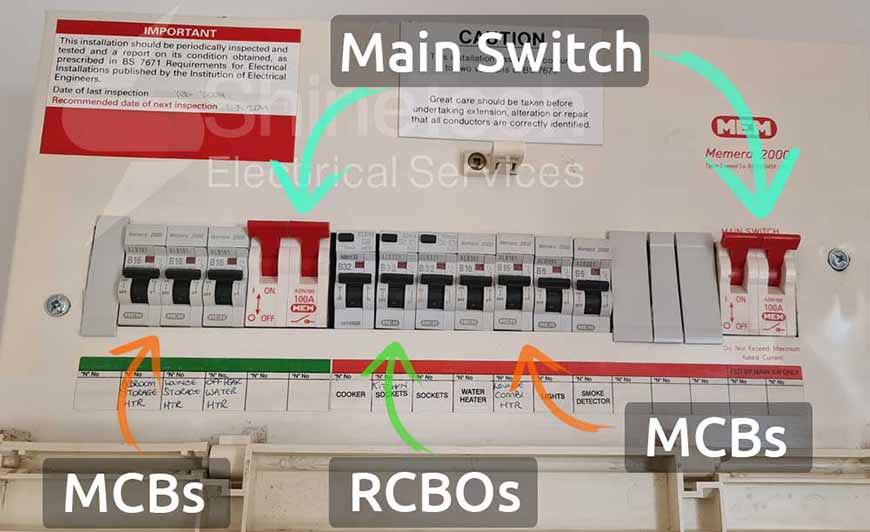
Residual Current Device (RCD or RCCB)
I, myself, have not come across the everyday term for RCDs and RCCBs, but it is handy to know that RCCB is a type of RCD. Usually, an RCD occupies two fuse spaces, and an RCCB occupies three to four fuse spaces. You may find them in different shapes, sizes, and colours, but one thing they all have in common is that they have a test button marked ‘TEST’ or ‘T’. As far as your home electrics is concerned, both of these devices serve the same purpose.
RCDs are life saving devices that prevent fatal electric shocks and electrical fires. RCD trip may cause inconvenience but remember that they are protecting you from apparent deadly electric hazards
RCDs trip when they detect an earth leakage in the circuit, which can happen if someone touches a live wire, for example. In some older installations, you may find them as the main switch too.
Remember, RCD protects a set of individual circuits, look at figure 3 below. If an RCD trips, all the circuits protected by that RCD stop working. This is a downside of an RCD – one single fault in a particular circuit may trigger RCD trip. Still, the RCD trip will affect all other fault free circuits protected by the same RCD.
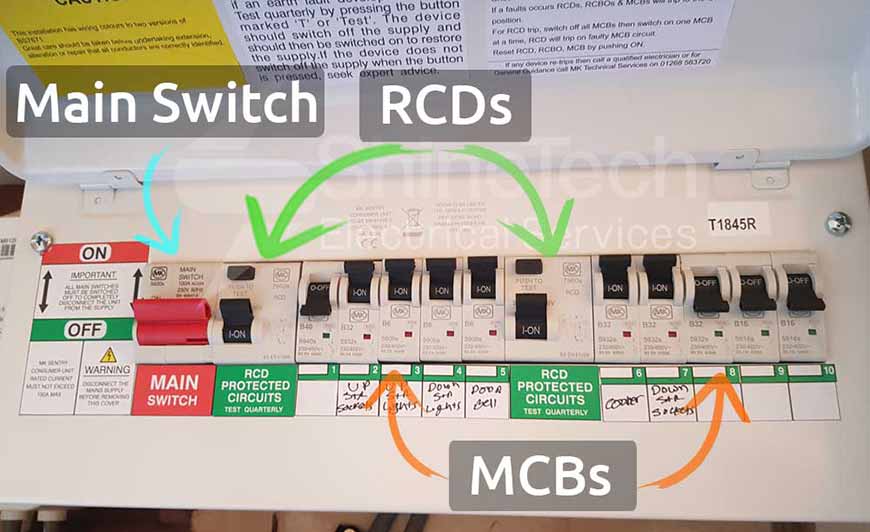

Fuse
Fuses are known as overcurrent protective devices, and I am sure all of us are familiar with them. They protect circuits (sections of cable protected by the fuse) from overloading. Generally, there are two types of fuses: semi-enclosed rewireable fuses or enclosed cartridge fuses.
The cartridge fuses are for a one-off use, so they cannot be re-used once they blow. The rewireable fuses can be re-wired with a special fuse wire and can be used again. Fuses operate automatically when they detect overload on the circuit. Note: in the modern fuse boards known as consumer units, these fuses have been replaced by MCBs or RCBOs.

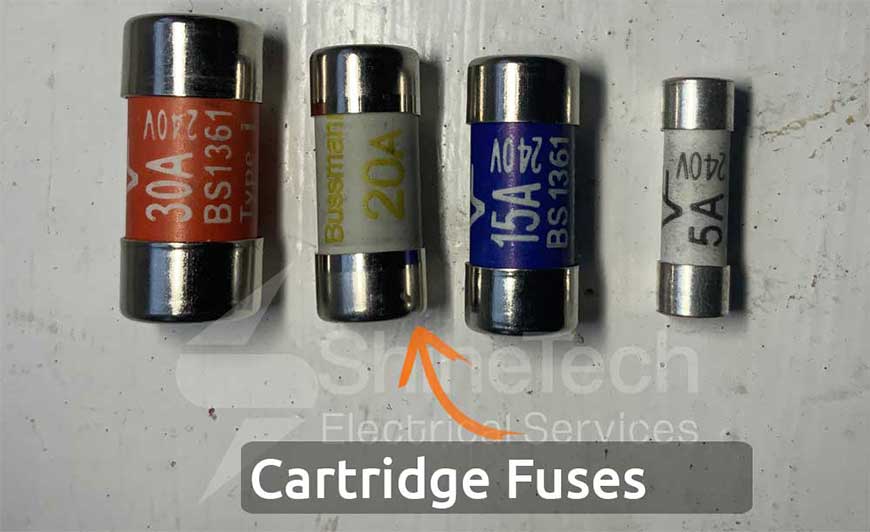


Miniature Circuit Breaker (MCB)
MCBs, RCBOs and AFDDs are often referred to as circuit breakers. However, RCBOs and AFDSS are not circuit just breakers.
MCBs are also called overcurrent protective devices and widely known as circuit breakers. These are the modern equivalent of the old rewireable or cartridge fuses.
MCBs protect circuits from overloading, in a way that is similar to the fuses above. MCBs are re-usable and they work pretty much like any other electrical rocker switches. They trip when they detect an overload on the circuit, including a short circuit.

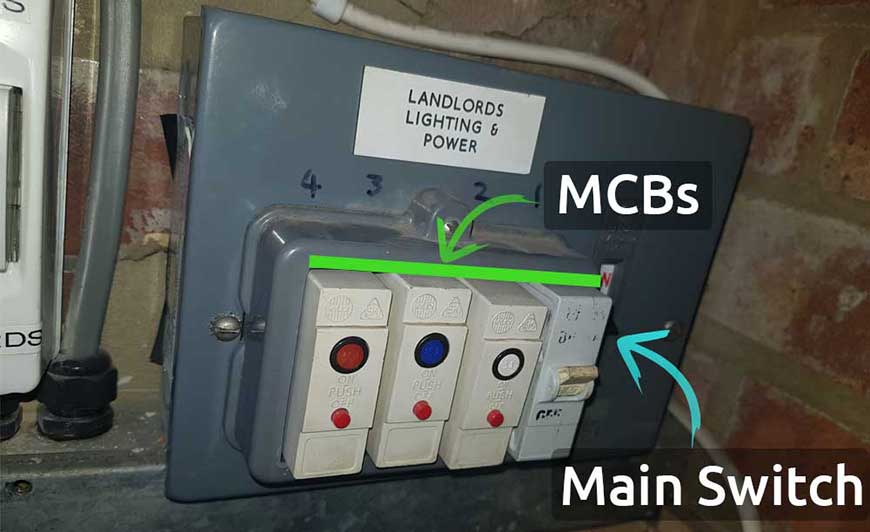

Residual Current Breaker with Overload (RCBO)
RCBO is a standalone device that replaces both MCB and RCD by combining them in one unit. An RCBO protects the circuit from overload while also protecting you from a fatal electric shock.
RCBOs look like MCBs, but they also have a test button marked ‘T’ or ‘Test’, similar to the RCD. These devices are a little bit pricey, but in the event of a fault, they avoid all the inconveniences that RCD causes.

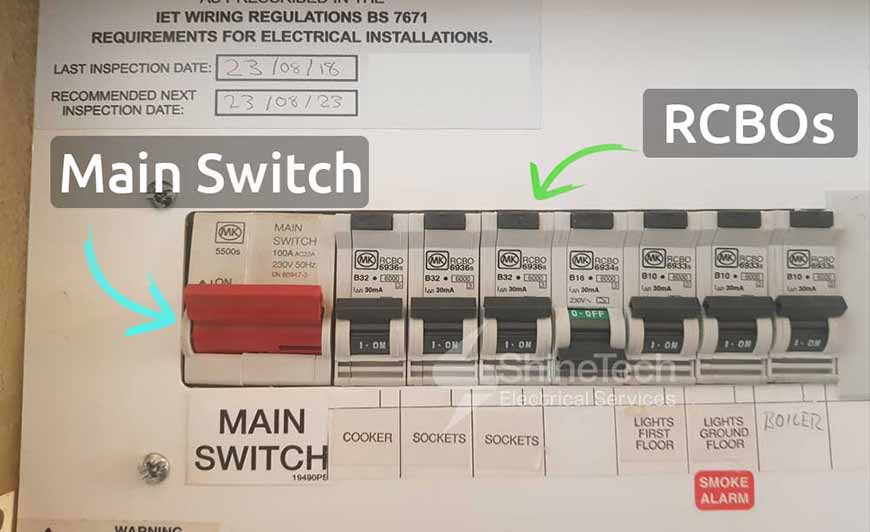
Surge Protection Device (SPD)
SPD prevents damage to an electrical installation and appliances in the event of an external power surge or overvoltage, which is usually known as voltage spike.
Unless your wiring is relatively new or you have recently upgraded the fuse board, you won’t find these devices in an older installation. Inclusion of SPD is a requirement of the BS7671 wiring regulations 18th edition, which came into effect on the 1st of January 2019. In regards to fuse tripping or power loss, SPD has no role to play.
There are some misconceptions that SPD protects from lightning strikes. However, this is not true. To protect a building or structure from a direct lightning strike, one must install a proper lightning protection system.
Arc Fault Detection Device (AFDD)
Many of us have not seen these devices in our consumer units yet. However, in a very near future, these devices are going to be “must install” devices in all new electrical installations, at least in domestic environments and in places like hospitals. An AFDD is a device that detects arcs and sparks in an electrical installation and automatically cuts off the power supply to the affected circuit.
Arcing is a source of electric fires.
Electrical arcing is commonly caused by:- Poor or loose electrical connections and joints
- Plugs that are defective or loose
- Poor or damaged insulation of a cable
- Faulty electrical appliances and accessories also can cause arching sometimes.

